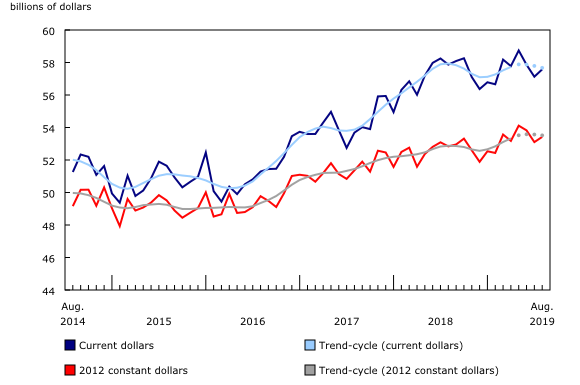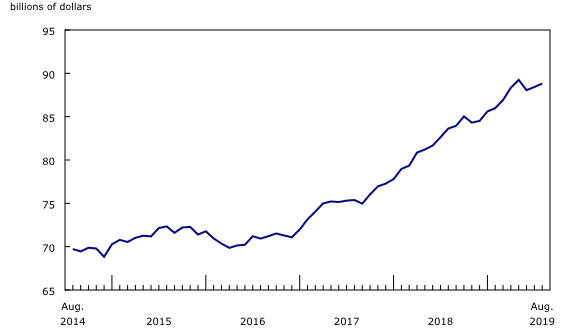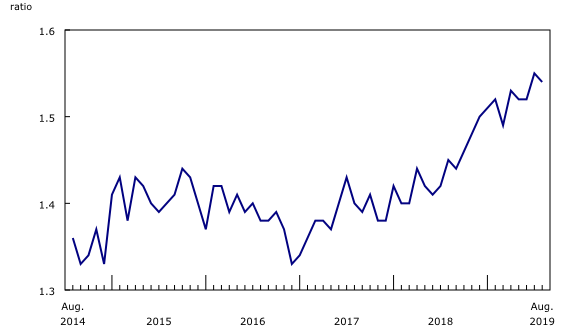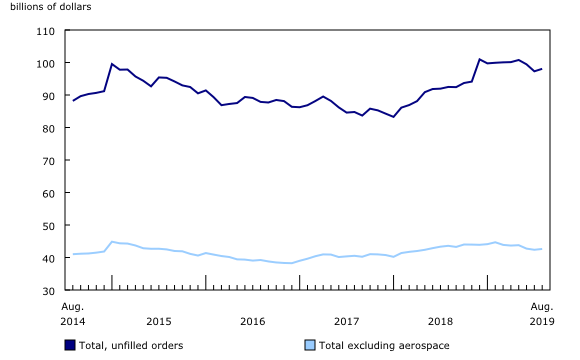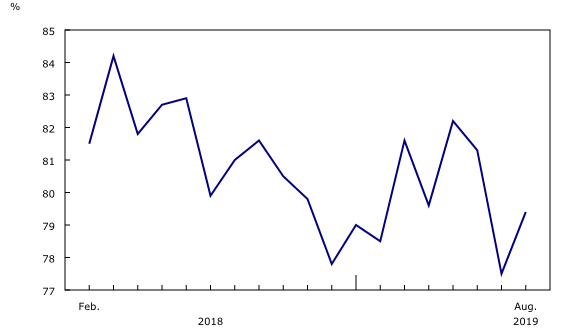Monthly Survey of Manufacturing, August 2019
Archived Content
Information identified as archived is provided for reference, research or recordkeeping purposes. It is not subject to the Government of Canada Web Standards and has not been altered or updated since it was archived. Please "contact us" to request a format other than those available.
Released: 2019-10-17
Manufacturing sales rose 0.8% to $57.6 billion in August, following two consecutive monthly declines.
Sales were up in 11 of 21 manufacturing industries representing 62.9% of the total manufacturing sector. The transportation equipment and fabricated metal industries were mainly responsible for the growth in August. The petroleum and coal product industry posted the largest decline.
Manufacturing sales in constant dollars increased 0.6% in August, reflecting higher volumes of goods sold.
Production ramp up in assembly plants
Sales in the transportation equipment industry increased 2.8% to $11.5 billion in August. All transportation equipment industries—except motor vehicle parts—reported higher sales in August. Sales in the motor vehicle industry rose 2.6% following a 4.6% decline in July and a 0.3% decrease in June. Sales in all major assembly plants began to ramp up in August after summer shutdowns that began in July and continued until early August. Production also increased in the aerospace product and parts industry and sales were up in the other transportation equipment industry.
Sales of fabricated metal products rose 3.6% in August following two consecutive monthly decreases. The gains in the fabricated metal industry were widespread but more pronounced in the architectural and structural metal industry. Sales of fabricated metal products in constant dollars were up 3.2%.
Sales also increased in the plastics and rubber product (+2.8%) and the food (+0.5%) industries. Many establishments in the plastic and rubber products industry reported higher sales in August due to higher demand. Food manufacturing rose for the second consecutive month in August, following a 1.0% increase in July.
Sales of petroleum and coal products decreased for the third consecutive month, declining 1.7% in August. Lower average prices, maintenance issues at a major petroleum refinery in Quebec, and lower sales in British Columbia led to the decline in August.
Sales were also down in the machinery (-1.6%) and furniture and related products (-2.8%) industries.
Quebec and Ontario lead the gains
Sales increased in seven provinces in August, led by Quebec and Ontario. British Columbia posted the largest decline.
Following a 1.2% decrease in July, manufacturing sales in Quebec rose 1.6% to $14.4 billion in August. Sales increased in 12 of 21 industries, led by plastic and rubber (+13.7%), fabricated metal (+7.8%) and wood (+11.3%) product industries. The gains in these industries were widespread across a number of manufacturers.
In Ontario, a 2.3% gain in motor vehicle sales drove the growth in August. The increase was partially offset by declines in several industries such as motor vehicle parts as well as plastics and rubber products.
In Saskatchewan, sales were up 7.0% to $1.4 billion, following a 3.5% increase in July. Higher sales of food products and chemicals were primarily responsible for the increase.
Manufacturing sales in British Columbia decreased for the fourth consecutive month, down 1.4% to $4.3 billion in August. Lower sales of petroleum and coal products and wood products contributed the most to the declines in August. The declines were partly offset by gains in the transportation equipment industry.
Manufacturing sales in Toronto increase
Manufacturing sales on unadjusted basis rose in 6 of 12 census metropolitan areas in August, led by Toronto (+7.3%) and Montréal (+3.7%).
In Toronto, higher sales of motor vehicles (+23.4%) and motor vehicle parts (+10.3%) were partly offset by lower sales in the beverage and tobacco and primary metal industries.
In Montréal, higher sales of transportation equipment drove the growth in August, reflecting gains in aerospace product and parts.
Manufacturing sales in Hamilton were down 1.6% to $1.6 billion in August due to lower sales in the chemical and transportation equipment industries.
Inventory levels rise in just over half of the industries
Following a 0.4% increase in July, total manufacturing inventories rose 0.5% to $88.8 billion in August as a result of higher inventory levels in aerospace product and parts (+3.9%) and machinery (+1.4%) industries. The gains were partially offset by lower inventories in the primary metal and petroleum and coal products industries.
The inventory-to-sales ratio fell from 1.55 in July to 1.54 in August, due to a larger gain in manufacturing sales than in total inventories. This ratio measures the time, in months, that would be required to exhaust inventories if sales were to remain at their current level.
Since January 2017, inventories have generally increased, rising from $72.0 billion that month to $88.8 billion in August 2019, a gain of 23.4%. Over this period, total sales increased by 7.1%. As a result, the inventory-to-sales ratio has also risen, from 1.34 to 1.54. Such a rise in the inventory-to-sales ratio has not been observed in the United States manufacturing sector, where the ratio has typically remained in the 1.34 to 1.38 range over the 2017 to 2019 period.
Unfilled orders up
Unfilled orders rose 0.8% to $98.1 billion in August. Higher unfilled orders of transportation equipment, in particular in the ship and boat building and the aerospace product and parts industries, were responsible for the growth.
After two consecutive monthly declines, new orders were up 6.1% to $58.3 billion in August. A large increase in new orders of aerospace product and parts was responsible for the gain.
Capacity utilization rate increases
The capacity utilization rate (not seasonally adjusted) for the total manufacturing sector increased 1.9 percentage points, from 77.5% in July to 79.4% in August.
The transportation equipment industry reported a strong increase in capacity utilization rate (+11.0 percentage points) in August as production started to ramp up at major assembly plants in Ontario as well as other transportation industries. The capacity utilization rate also increased in the wood (+2.4 percentage points) and the plastic and rubber (+2.4 percentage points) product industries.
The capacity utilization rate in the petroleum and coal product industry decreased 1.1 percentage points in August as a result of lower production due to shut downs for maintenance at some refineries in Quebec and British Columbia.
Sustainable Development Goals
On January 1, 2016, the world officially began implementation of the 2030 Agenda for Sustainable Development—the United Nations' transformative plan of action that addresses urgent global challenges over the next 15 years. The plan is based on 17 specific sustainable development goals.
The Monthly Survey of Manufacturing is an example of how Statistics Canada supports the reporting on the Global Goals for Sustainable Development. This release will be used in helping to measure the following goal:

Note to readers
Monthly data in this release are seasonally adjusted and are expressed in current dollars unless otherwise specified.
For information on seasonal adjustment, see Seasonally adjusted data – Frequently asked questions. For information on trend-cycle data, see Trend-cycle estimates – Frequently asked questions.
Non-durable goods industries include food, beverage and tobacco products, textile mills, textile product mills, clothing, leather and allied products, paper, printing and related support activities, petroleum and coal products, chemicals, and plastics and rubber products.
Durable goods industries include wood products, non-metallic mineral products, primary metals, fabricated metal products, machinery, computer and electronic products, electrical equipment, appliances and components, transportation equipment, furniture and related products, and miscellaneous manufacturing.
Production-based industries
For the aerospace and shipbuilding industries, the value of production is used instead of the value of sales of goods manufactured. The value of production is calculated by adjusting monthly sales of goods manufactured by the monthly change in inventories of goods in process and finished products manufactured. The value of production is used given the extended period of time that it normally takes to manufacture products in these industries.
Unfilled orders are a stock of orders that will contribute to future sales if the orders are not cancelled.
New orders are those received, whether sold in the current month or not. New orders are measured as the sum of sales for the current month plus the change in unfilled orders from the previous month to the current month.
Manufacturers reporting sales, inventories and unfilled orders in US dollars
Some Canadian manufacturers report sales, inventories and unfilled orders in US dollars. These data are then converted to Canadian dollars as part of the data production cycle.
For sales, which are assumed to occur throughout the month, the average exchange rate for the reference month established by the Bank of Canada is used for the conversion. The monthly average exchange rate is available in table 33-10-0163-01. Inventories and unfilled orders are reported at the end of the reference period. For most respondents, the daily average exchange rate on the last working day of the month is used for the conversion of these variables.
However, some manufacturers choose to report their data as of a day other than the last day of the month. In such cases, the daily average exchange rate on the day selected by the respondent is used. As a result of exchange rate fluctuations, the daily average exchange rate on the day selected by the respondent can differ from both the exchange rate on the last working day of the month and the monthly average exchange rate. Daily average exchange rate data are available in table 33-10-0036-01.
Revision policy
Each month, the Monthly Survey of Manufacturing releases preliminary data for the reference month and revised data for the previous three months. Revisions are made to reflect new information provided by respondents and updates to administrative data.
Once a year, multiple years of data are revised.
Real-time data tables
Real-time data tables 16-10-0118-01, 16-10-0119-01, 16-10-0014-01 and 16-10-0015-01 will be updated on October 28.
Next release
Data from the Monthly Survey of Manufacturing for September will be released on November 19.
Contact information
For more information, or to enquire about the concepts, methods or data quality of this release, contact us (toll-free 1-800-263-1136; 514-283-8300; STATCAN.infostats-infostats.STATCAN@canada.ca) or Media Relations (613-951-4636; STATCAN.mediahotline-ligneinfomedias.STATCAN@canada.ca).
- Date modified:




